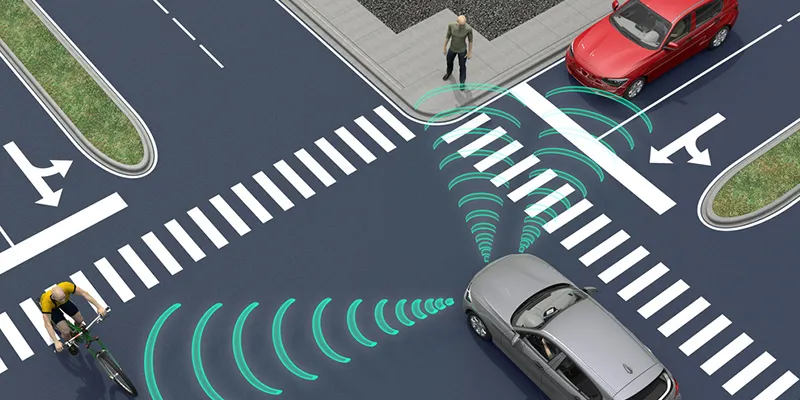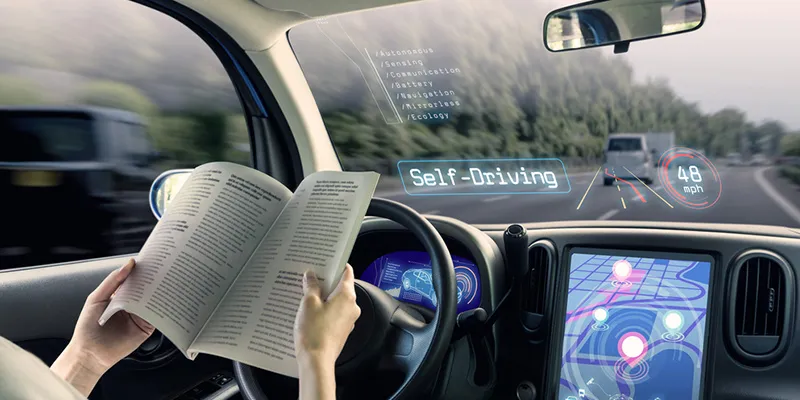An overview of the 2 key technologies NXP Semiconductors sees driving the connected car revolution
What are connected cars and the technologies driving them forward? Here is a brief overview of some of the key technologies that are core to what has been dubbed the ‘supercomputers on wheels’ or ‘cars of the future’.
'Connected vehicles' has been a buzzword for some time now. But since the technology is still in its infancy and not yet mass market, there is some ambiguity around it. Most of the focus on connected vehicles seems to be regarding connecting IoT devices or smart sensors with different moving parts of a vehicle. But some others have a broader definition, where different vehicles on a road communicate with each other, like different computer nodes on the infobahn (or more popularly, the information superhighway).
YourStory recently spoke to Sanjay Gupta, VP and India Country Manager at NXP Semiconductors, to understand how the Dutch multinational looks at the connected car space and what technologies are driving it forward. Here are some highlights.

Supercomputers on wheels?
Sanjay noted that because of wireless technologies like vehicle-to-everything (V2X) communications, telematics, near-field communication (NFC), and multi-standard digital broadcast reception complemented by advanced driver-assistance systems (ADAS) that implement autonomous driving features, cars of the future will be supercomputers on wheels. He noted, “NXP looks at connected cars as cars which are internet- and wireless connection- enabled.”
Drawing another analogy, Sanjay elaborated that modern vehicles will continuously generate, process, exchange, and store large amounts of data. Their wireless interfaces connect the in-vehicle systems of these ‘connected cars’ to external networks such as the internet, enhancing the consumer experience by enabling new features and services. So NXP’s definition of connected cars includes connectivity both inside and outside vehicles.
Sanjay believes that these connected vehicles will help drivers prevent long congestions and fatigue. He said,
It would also help the drivers by providing them with easy navigation, entertaining them with music, and by making the journey comfortable overall.
Here are two of the key technologies that are at the forefront of making connected cars a reality.
a) Advanced driver-assistance systems
ADAS, one of the foundations of automated cars, is growing ever stronger. Sanjay explained,
The proliferation of sensors in today’s vehicles is fuelling the rapid evolution of ADAS. This development, in turn, is flagging the path to piloted drive and fully autonomous vehicles.
Talking about the paradigm shift towards mass adoption, Sanjay noted that at one time, ADAS systems were the domain of only high-end luxury cars but they are now finding their way into mid-range and economy vehicles. Many automobile and tech giants including GM, Uber, and Tesla Motors, to name a few, seem to be in a race to develop and ship affordable autonomous vehicles into the market.

However, there are several challenges with respect to developing ADAS, including high development costs, compliance with rigorous safety certifications, and integration of ADAS components from multiple suppliers.
b) 5G technology
As ones of the leaders in radio frequency (RF) power transistors for the cellular infrastructure market, NXP is building up its technology and product portfolio for 5G markets with a focus on the three key enablers of 5G:
- Increased throughput
- Lower latency
- IoT for billions of connected devices
Sanjay noted that because of NXP’s strength in the semiconductor technology space, it allows product options for 5G that span frequency and power spectrums with varying levels of integration. He said,
There is no doubt in the number of benefits 5G technology holds. To bring these capabilities in use, radio architectures need to significantly evolve and utilise macro to small cell base stations that operate in frequency bands from a few hundred megahertz to tens of gigahertz.
By introducing 5G technology streaming high-quality videos, connecting a multitude of devices and allowing real-time communications between people and vehicles would become a lot faster and easier. To enable these capabilities, Sanjay noted that NXP’s comprehensive portfolio of low- and high-power RF technologies are being combined to address 5G demands of bandwidth, linearity, power efficiency, and small form factor solutions.
The importance of building security protocols
In terms of connected vehicles, overall, these cars possess a lot of features like front and rear camera systems which are used to detect pedestrians and implement braking functions. Then there are surround view camera systems which help automate parking functions, LiDAR which helps vehicles ‘see’ in the dark, and the list goes on. However, ensuring that each vehicle has the highest level of security against unwanted hacks is of the utmost importance. All these electronic functions bring great benefits to the driver but come with new risks, too. Sanjay explained,
Securing connected cars internally and externally is crucial for electronics providers as well as connectivity services providers.
Connected cars can be vulnerable to hackers, who attack the vehicle by seeking and exploiting weaknesses in its computer systems or networks. Several studies some years ago have already warned that hacking into a car is possible, and hackers recently demonstrated that they could indeed gain remote control over vehicles.
This implies a paradigm shift in the design of in-vehicle electronics. Traditionally, there has been a strong focus on safety, meaning that for example, the brakes should function correctly under all circumstances. Sanjay believes that safety will remain equally important in the future, but the increasing amount of electronics and software in vehicles will require additional security to protect the vehicle against hackers.
Hence, connected cars must be secured to ensure the correct functioning of all in-vehicle systems as well as user privacy. Sanjay said,
Analysing the industry overall, it is estimated that vehicles have been changing drastically and it is expected that connected vehicles will be a reality by 2020. NXP put together a framework consisting of four security layers that lead to a highly secure vehicle network.
Four layers in new-age cars:
- Secure interfaces, which connect the vehicle to the external world
- Secure gateway, which provides domain isolation (separating interfaces, infotainment, safety-critical systems etc.)
- Secure network, which provides secure communication between control units (ECUs)
- Secure processing units, which implement all the features of the connected car
Each connected component has its own specific security challenges. So, NXP believes that a four-layer security framework provides a holistic approach for securing the complete vehicle architecture, using a defence-in-depth strategy. The framework provides the right level of protection and countermeasures to individually address the security needs for each one. Sanjay said,
This structured approach delivers multiple levels of defence, from the vehicle’s perimeter to the individual electronic control units (ECUs), eliminating vulnerabilities.
Do the pros of connected vehicles outweigh the cons?
As part of a smarter world, the connected car will be highly connected to and constantly interacting with its environment. Sanjay believes that it brings enormous promises for increased comfort, safety, and efficiency. He said,
The future of automobiles would be much smarter and safer than the current time. Also, automobiles will no more be just a means of commuting but a progressive and personalised information hub. Innovations are helping create a more entertaining, customised experience for consumers as well as making driving safer and easier.

NXP believes that these vehicles, offering car owners multiple possibilities, will prove a boon to the people. They will be able to drop their cars off at the garage for service and monitor the progress from the office, hand over control to the cars in traffic jams, or benefit from next-generation connected infotainment services. In the long term, Elon Musk, CEO of Tesla, noted in Master Plan Part 2 that autonomous cars could also possibly generate income for car owners by functioning as cabs and ferrying people to and from locations while they work away at their offices.
Website- NXP Semiconductors







